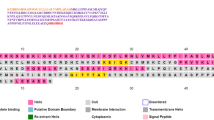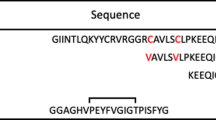Abstract
The 4kD scorpion defensin (SD) is a potent disulfide-linked peptide. In this study, we expressed it in methylotrophic yeast Pichia pastoris and purified it using Ni–NTA His Bind Resin. We investigated its in vitro antibacterial activity and effect in combination with several conventional antibiotics. We first examined its antibacterial activity towards several Gram-positive and Gram-negative bacteria. Then we used the broth microdilution method to test drugs alone and in combination and used the fractional inhibitory concentration (FIC index) to classify the drug interactions. Our study showed the expressed SD peptide has antibacterial activity against Salmonella typhimurium, E. coli and S. aureus etc. Synergy or additive interaction was observed between SD and Norfloxacin, Polymyxin B and Ampicillin. Cell growth tests showed that combination of SD and Norfloxacin can improve their activity against bacteria. This result maybe permit lower using of the conventional antibiotic agents more effectively and safely.


Similar content being viewed by others
Abbreviations
- SD:
-
The 4 kDa scorpion defensin
- FIC:
-
Fractional inhibitory concentration
References
Allen HK, Donato J, Wang HH et al (2010) Call of the wild: antibiotic resistance genes in natural environments. Nat Rev Microbiol 8:251–259
Andersson DI, Hughes D (2010) Antibiotic resistance and its cost: is it possible to reverse resistance? Nat Rev Microbiol 8:260–271
Ausubel FMR, Brent RE (1996) Protocols in molecular biology, 3rd ed. Trends Cell Biol 6:366–367
Bechinger B (1997) Structure and functions of channel-forming peptides: magainins cecropins, melittin and alamethicin. J Member Biol 156:197–211
Bell A (2011) Antimalarial peptides: the long and the short of it. Curr Pharm Des 17(25):2719–2731
Berenbaum MC (1978) A method for testing for synergy with any number of agents. J Infect Dis 137:122–130
Bhunia A, Saravanan R, Mohanram H, Mangoni ML, Bhattacharjya S (2011) NMR structures and interactions of temporin-1Tl and temporin-1 Tb with lipopolysaccharide micelles: mechanistic insights into outer membrane permeabilization and synergistic activity. J Biol Chem 286:24394–24406
Boman HG (1995) Peptide antibiotics and their role in innate immunity. Annu Rev Immunol 13:61–92
Branen JK, Davidson PM (2004) Enhancement of nisin, lysozyme and monolaurin antimicrobial activities by ethylenediaminetetraacetic acid and lactoferrin. Int J Food Microbiol 90:63–74
Cao ZJ, Luo F, Wu YL, Mao X, Li WX (2006) Genetic mechanisms of scorpion venom peptide diversification. Toxicon 47:348–355
Chopra I, Hawkey PM, Hinton M (1992) Tetracyclines molecular and clinical aspects. J Antimicrob Chemother 29:245–277
Cipakova I, Hostinova E, Gasperik J, Velebny V (2004) High-level expression and purification of a recombinant hBD-1 fused to LMM protein in Escherichia coli. Protein Expr Purif 37:207–212
Cociancich S, Goyffon M, Bontems F et al (1993) Purification and characterization of a scorpion defensin, a 4 kDa antibacterial peptide presenting structural with insect defensins and scorpion toxins. Bioche Biophy Res Com 194:17–22
Ellie JC, Goldstein MD (1987) Norfloxacin a fluoroquinolone antibacterial agent: classification mechanism of action and in vitro activity. Am J Med 82(6):3–17
Fan S, Sun Z, Jiang D et al (2010) BmKCT toxin inhibits glioma proliferation and tumor metastasis. Cancer Lett 291:158–166
Fu F (2010) Tandem expression of antimicrobial peptides Protegrin-1 & PR-39 in E. coli and Alfalfa. College of Animal Sciences Zhejiang University Hangzhou, Zhejiang university, China
Gao B, Xu J, Rodriguez MC et al (2010) Characterization of two linear cationic antimalarial peptides in the scorpion Mesobuthus eupeus. Biochimie 92:350–359
Ibrahim HR, Sugimoto Y, Aoki T (2000) Ovotransferrin antimicrobial peptide (OTAP-92) kills bacteria through a membrane damage mechanism. Biochim Biophys Acta 1523:196–205
Ingham AB, Moore RJ (2007) Recombinant production of antimicrobial peptides in heterologous microbial systems. Biotechnol Appl Biochem 47:1–9
Jenssen H, Hamill P, Hancock RE (2006) Peptide antimicrobial agents. Clin Microbiol Rev 19:491–511
Jin FL, Xu XX, Zhang WQ, Gu DX (2006) Expression and characterization of a housefly cecropin gene in the methylotrophic yeast Pichia pastoris. Protein Expr Purif 49:39–46
Kohanski MA, Dwyer DJ, Collins JJ (2010) How antibiotics kill bacteria: from targets to 558 networks. Nat Rev Microbiol 8:423–435
Maisetta G, Petruzzelli R, Franca LB et al (2010) Antimicrobial activity of human hepcidin 20 and 25 against clinically relevant bacterial strains: effect of copper and acidic pH. Peptides 31:1995–2002
Matthew EF, Petros IR, Dimitrios KM (2010) Resistance to polymyxins: mechanisms frequency and treatment options. Drug Resist Updates 13:132–138
Michael T (2001) Veterinary use and antibiotic resistance. Curr Opin Microbiol 4:493–499
Naghmouchi K, Drider D, Fliss I (2007) Action of divergicin M35:a class IIa bacterio cin on liposomes and Listeria. J Appl Microbiol 102:1508–1517
Nicolas P, Mor A (1995) Peptides as weapons against microorganisms in the chemical defense system of vertebrates. Annu Rev Microbiol 4:277–304
Niu MF, Li X, Wei JC et al (2008) The molecular design and expression of a recombinant antimicrobial peptide CP and its in vitro activity. Protein Expr Purif 57(1):95–100
Peters BM, Shirtliff ME, Jabra-Rizk MA (2010) Antimicrobial peptides: primeval molecules or future drugs? PLoS Pathog 6(10):e1001067. doi:10.1371/journal.ppat.1001067
Possani LD, Merino E, Corona M, Bolivar F, Becerril B (2000) Peptides and genes coding for scorpion toxins that affect ion-channels. Biochimie 82:861–868
Qi XB, Zhou CC, Li P et al (2010) Novel short antibacterial and antifungal peptides with low cytotoxicity: efficacy and action mechanisms. Biochem Bioph Res Co 398:594–600
Qiu YL, Young MC, Hyung Y, Byung RJ (2012) Molecular cloning and antibacterial activity of bombolitin isolated from the venom of a bumblebee Bombus terrestris. J Asia Pac Entomol 15:21–25
Ren XY, Kong QJ, Wang HL et al (2012) Biocontrol of fungal decay of citrus fruit by Pichia pastoris recombinant strains expressing cecropin A. Food Chem 131:796–801
Rodriguez de la Vega RC, Possani LD (2004) Current views on scorpion toxins specific for K+-channels. Toxicon 43:865–875
Sambrook J, Russel D (2001) Molecular cloning: a laboratory manual. Cold Spring Harbor Laboratory Press, New York
Sang Y, Blecha F (2009) Porcine host defense peptides: expanding repertoire and functions. Dev Comp Immunol 33:334–343
Schelz Z, Molnar J, Hohmann J (2006) Antimicrobial and antiplasmid activities of essential oils. Fitoterapia 77:279–285
Spickler C, Brunelle MN, Brakier-Gingras L (1997) Streptomycin binds to the decoding center of 16 S ribosomal RNA. J Mol Biol 273:586–599
Toit EA, Rautenbach M (2000) A sensitive standardized micro-gel well diffusion assay for the determination of antimicrobial activity. J Microbiol Methods 42:159–165
Tomasz K, Natalia G, Tomasz D (2010) Does ciprofloxacin have an obverse and a reverse? Pulm Pharmacol Ther 23:373–375
Xu X, Li J, Lu Q et al (2006) Two families of antimicrobial peptides from wasp (Vespa magnifica) venom. Toxicon 47:249–253
Yan L, Adams ME (1998) Lycotoxins antimicrobial peptides from venom of the wolf spider Lycosa carolinensis. J Biol Chem 273:2059–2066
Yang JH, Cai J, Hu Y et al (2012) Preparation characterization and antimicrobial activity of 6-amino-6-deoxychitosan. Carbohydr Polym 87:202–209
Acknowledgments
We thank Pro. Wang Chuanqing for kindly offering the bacterial strains. This work was supported by grants of Henan University of Science and Technology Youth Fund Project (2010QN0015) and Ph.D. Programs Foundation (09001279).
Conflict of interest
The authors declare there are no conflicts of interest.
Author information
Authors and Affiliations
Corresponding author
Rights and permissions
About this article
Cite this article
Niu, M., Li, X., Gong, Q. et al. Expression of 4kD scorpion defensin and its in vitro synergistic activity with conventional antibiotics. World J Microbiol Biotechnol 29, 281–288 (2013). https://doi.org/10.1007/s11274-012-1181-4
Received:
Accepted:
Published:
Issue Date:
DOI: https://doi.org/10.1007/s11274-012-1181-4




